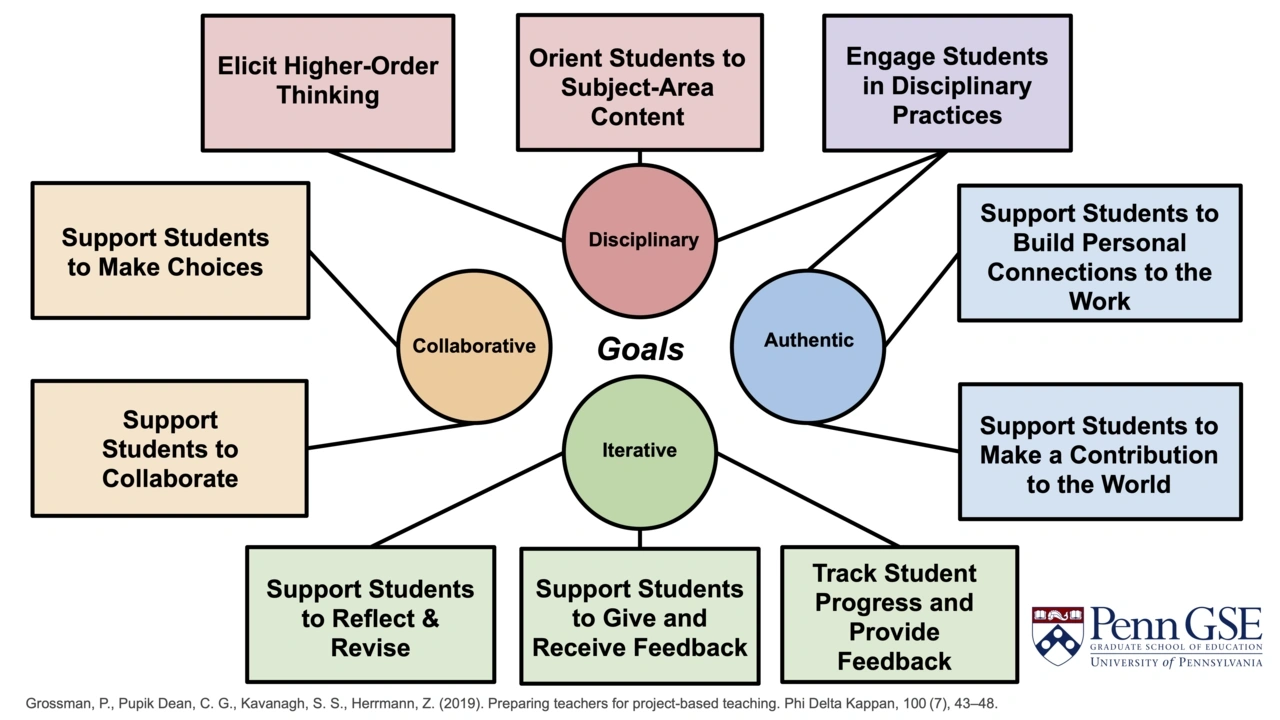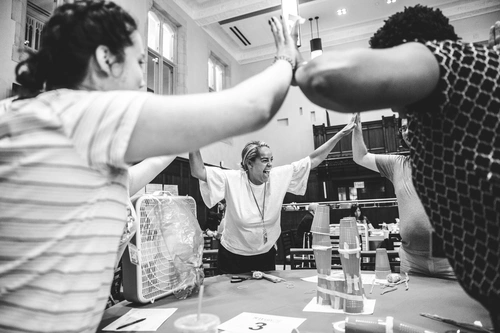The Core Practices for Project-Based Learning Framework
Project-Based Learning is a remarkably powerful approach to teaching and learning, but is also remarkably challenging to do it well. Teachers must draw on extensive knowledge and many skills in order to facilitate Project-Based Learning effectively. And so at Penn GSE, we've studied the teaching practices that support the ambitious learning objectives of Project-Based Learning and identified four driving goals of Project-Based Learning that focus on what students learn, as well as ten core teaching practices that focus on what teachers do to support it.
The four driving goals of Project-Based Learning include Disciplinary Learning, Authentic Work, Collaboration, and Iteration. These goals are what teachers hope students will achieve through project-based instruction.
In order to support teachers' pursuit of these four goals in their daily instruction, we have identified core practices associated with each of these goals that can be enacted across disciplines and contexts.
Read on to learn more about each of these four core practices, as well as view guiding questions, example instructional moves and strategies, and resources for implementing these practices into your own context.

Disciplinary Learning
A core goal of Project-Based Learning is that students explore and deepen their understanding of the core content, questions, and practices within the disciplines. In other words, what are the big ideas and the tools and strategies of history or mathematics or science? In Project-Based Learning, rather than asking students to learn about history, we actually engage them in doing historical inquiry. Students are not learning about science, they are actually creating and engaging in scientific inquiry to construct knowledge on their own.
Consider the following questions as you plan a project and as you reflect on your own teaching, and consider the changes and modifications you can make to create more opportunities and provide more support for students to engage in rich disciplinary learning.
Teachers support students to do the kinds of work that practitioners actually do.
Ask Yourself...
- How am I encouraging all students to think, talk, and act like historians, scientists, mathematicians, civically-minded individuals, etc.?
- Is what all students are doing right now a thing that a scientist, historian, mathematician, legislator, or other professional would actually do in the course of their work?
Try This...
- Engage students in tasks that are open-ended, require different approaches and skills in order to be completed successfully, and which require students to engage in several different disciplinary practices.
- Disrupt common perceptions of "intelligence" or "competence" by conducting a "Multiple Abilities Status Treatment" at the onset of the project.
- Name the different skills and abilities that will be necessary to complete the activity by referring to the disciplinary practices that will be required.
- Convince students that the task relies on multiple abilities, and that every student will bring value and different abilities to their team–no one will have all of the abilities but everyone will have some.
To elicit higher-order thinking, teachers support students to evaluate, analyze, test, or critique information.
Ask Yourself...
- How will I hold all students to high expectations, and support each student to reach them?
- What question, prompt, or problem can I share with each student to push their thinking?
- How can I encourage all students to synthesize, evaluate, justify, or defend?
Try This...
- Engage students in projects, tasks, and activities that are inherently open-ended and uncertain, such that there is no right answer and their process and choices decide the direction of their group product.
- Engage students in multiple-ability projects, tasks, and activities that require students to engage several different abilities in order to be successful.
- Encourage students to justify their arguments, explore alternative solutions, and examine issues from different perspectives.
Teaches continually center core disciplinary understandings, key concepts, or big ideas of their academic subject or discipline. Content and learning goals remain the focus, while students pursue answers to authentic questions of an academic discipline.
Ask Yourself...
- How can I help all students connect their work on the project with core ideas, skills, or content of the subject area?
- Is what we're doing right now intimately connected to core ideas, skills, or content in my subject area? Is what we are grappling with important and meaningful?
Try This...
- Engage students in project, tasks, and activities that deal with a central concept or big idea of the discipline.
- Provide specific evaluation criteria for the group product with clear connections between the activity and the central concept.
Authentic Learning
PBL engages students in exploring questions and problems that are relevant to themselves as individuals, their communities, and the world. This means that students have opportunities to draw on their own insights, interests, experiences, knowledge, perspectives, and skills to explore and make sense of what they're learning about. They also have opportunities to draw connections between that they're learning about in school and problems that exist in the broader community.
Consider the following questions as you plan a project and as you reflect on your own teaching, and consider the changes and modifications you can make to create more opportunities and provide more support for students to engage in rich authentic learning.
To support students to build personal connections to their work, we can ask students to share their personal opinions about the work in which they're engaged. And students are asked to consider: what does the work mean to me?
Ask Yourself...
- Why is this work important or meaningful to my students?
- How can I support all students to build deeper connections between themselves and their work?
- Which of my students appear most engaged? Which of my students should I learn more about? How will I be curious about my students?
Try This...
- Spend time getting to know your students through one-on-one conversations and empathy interviews.
- Consider if and how your students' identities are represented in the topics and content that you're covering.
- Create opportunities for students to consider what they're learning in light of their own experiences, beliefs, values, or interests.
Create opportunities for students to take on real-world roles as they work on authentic problems and create products that have a meaningful impact on themselves or their communities.
Ask Yourself...
- Is this work addressing a real question, problem, or need?
- Are all of my students taking on real-world roles as they engage in this work?
- Are my students working with materials, data, or text that are also used outside of school?
- Will the product of my students' work contribute to someone or some community?
Try This...
- Consider how all of these authentic elements come together in your project.
- Hook students with an intriguing artifact or experience, such as a newspaper article, field trip, demonstration, or data set, and have them generate questions based on their own curiosities.
Collaboration
Most authentic problems require people to work together to solve them. PBL creates opportunities for students to practice and develop their skills at working with others on meaningful and complex questions and challenges.
Consider the following questions as you plan a project and as you reflect on your own teaching, and consider the changes and modifications you can make to create more opportunities and provide more support that enhance collaboration for students.
Resist making all of the choices yourself throughout the project. Instead, offer students support for making big and small decisions that will affect their processes and their products.
Ask Yourself...
- Where am I giving all students opportunities to make real and consequential choices?
- What support am I providing so that all students develop as thoughtful decision-makers?
Try This...
- Ask students to choose between a set of predetermined options, and provide a justification for their decision.
- Create predictable routines that allow students to lower their level of stress and "collect themselves."
- Consider asking a question rather than making a correction.
Actively support student collaboration by defining student roles and responsibilities, designing and managing group processes, and supporting students to reflect on, and refine, their collaborative efforts. Scaffold collaboration and closely monitor participation, communication, and teamwork throughout collaboration. Intervene when necessary to support students' capacity to work effectively together.
Ask Yourself...
- What opportunities am I providing for all students to work together on meaningful and interdependent work?
- How am I monitoring student participation within groups, and what supports am I providing to encourage equitable participation?
- What status issues am I seeing within groups? How will I disrupt harmful or unproductive patterns of talk and participation? Read more about equity in cooperative classrooms here.
Try This...
Design a task, project, or activity that is appropriate for collaboration.
- Require both a group and individual product.
- Design a task, project, or activity that requires positive interdependence, where students must depend on each other to be successful.
Support students to collaborate effectively.
- Support students with collaboration protocols.
- Determine which roles will best support student collaboration and learning, and support students to play those roles effectively.
- Establish clear behavior expectations, including the supportive behaviors you expect to see.
- Create space for students to reflect on their groups' process and effectiveness; for example, by conducting an after-action review.
Monitor groups and intervene when necessary.
- Reinforce productive decisions by acknowledging when students attempt to make healthy connections with others or regulate their behavior.
- Observe groups for several minutes and take notes on interactions. Afterwards, discuss the quality of the group interactions using the observed evidence.
Iteration
In many classrooms, one of the goals of PBL is to position students as active and iterative designers and creators. Whether it's ideas, arguments, or proposals, they're constantly iterating and improving their work.
Consider the following questions as you plan a project and as you reflect on your own teaching, and consider the changes and modifications you can make to create more opportunities and provide more support to make learning iterative for students.
Provide feedback on student work throughout a given unit or project, rather than solely at its completion. Keep in mind that student feedback is not rationale for a grade; instead, it's useful suggestions that students are expected to use to improve their thinking and work.
Ask Yourself...
- What intentional opportunities am I giving all students to review each other's work and provide feedback?
- What supports do all students need to give and receive high-quality feedback?
Try This...
- Provide clear evaluation criteria that reflects multiple abilities
- Co-create rubrics with students and support them as they track their growth
Give students the opportunity to see and critique each other's in-progress work. Support students to learn the skills of giving and receiving feedback.
Ask Yourself...
- How am I assessing or tracking the progress of each student? What data am I gathering about where each student is?
- How am I using that data to support each student?
- How can I support all students to engage in self-assessment or self-tracking?
Try This...
- Determine and communicate a specific feedback protocol. This may include modeling respectful communication and establishing clear behavior expectations, including the supportive behaviors you expect to see.
- Ask students to select a specific target area and ask their peers for feedback.
- Create several cycles of feedback.
Teachers dedicate time and provide ample support for students to reflect on their progress and to revise their plans, thinking, and work.
Ask Yourself...
- What intentional opportunities am I creating for all students to reflect on their work?
- How am I supporting all students as they use their reflections to revise and improve their work?
Try This...
- Provide clear evaluation criteria that incorporate a broad set of learning goals.
- Ensure that students have several opportunities to receive feedback, and that those opportunities are timely and ongoing.
- Give students opportunities and support to revise their work after receiving feedback.
Justice Imperative

Project-Based Learning can be a powerful tool to disrupt inequitable patterns in who has access to a meaningful and fulfilling education. When done thoughtfully, Project-Based Learning has the capacity to create learning environments that are rich in (inter)disciplinary learning, authentic to students and their communities, collaborative, and iterative. However, like many approaches to teaching and learning, when done without high levels of intention and skill, Project-Based Learning can serve to reinforce inequitable, unjust, and problematic realities.
The Penn GSE PBL program is committed to helping teachers build their capacity to pursue the four driving goals of Project-Based Learning through the high-quality and equitable enactment of the ten core teaching practices of Project-Based Learning in ways that support all students to grow, develop, and flourish.
About the Research Team
A lot of work has been done around curriculum design of projects, but we know that curriculum doesn't teach itself. While Project-Based Learning requires a strong project idea, it also requires thoughtful and skilled teaching in order for students to fully realize the potential of the project. The Penn GSE Project-Based Learning project has focused on the knowledge, skills, and mindsets that teachers need to enact Project-Based Learning and how teachers develop as Project-Based Learning educators.



